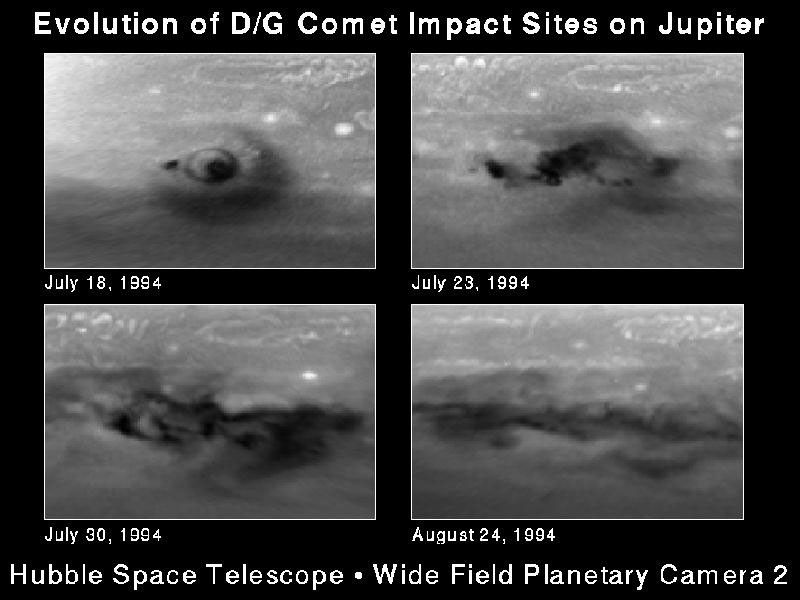1 min read
The D/G Jupiter Impact Sites from Comet P/Shoemaker-Levy 9

This series of snapshots, taken with NASA's Hubble Space Telescope, shows evolution of the comet P/Shoemaker-Levy 9 impact region called the D/G complex. This feature was produced by two nuclei of comet P/Shoemaker-Levy 9 that collided with Jupiter on 17 and 18 July 1994, respectively, and was later modified again by the impact of the S fragment on 21 July 1994.
Upper Left: This first image was taken about 90 minutes after the G impact on 18 July 1994. Nearly all of the structure in this image was created by the impact of fragment G, although a small dark spot to the left was the remainder of small fragment D that collided one day earlier. The explosion of the nucleus in Jupiter's atmosphere created the unique ring structure, which may be analogous to a "sonic boom" on earth. Though this structure is best seen for the G impact, it is not unique. Hubble reveals similar rings around several other fresh impact sites. They are all clear evidence for coherent outward motion of this wave phenomena.
Upper right: This second image, obtained on 23 July, shows that the Jovian winds have swept the material into a striking "curly-cue" structure.
Lower left, right: The structure seen in earlier views has disappeared rapidly in the images taken on 30 July and 24 August, respectively. Almost all of the changes between the images are due to Jupiter's east-weat winds that play a key role in the dispersing of the dark material.
Hubble Space Telescope's high resolution will allow astronomers to continue to trace the impact debris as it is transported by the Jovian winds. This information promises to advance current understanding of the physics of Jupiter's atmosphere.
These black and white images were taken in near-ultraviolet light with the Wide Field Planetary Camera 2. They have been processed to correct for the curvature of Jupiter, so that the impact region appears flat, as if the viewer were hovering directly overhead. Each image is centered on 46 degrees latitude and 28 degrees. The north-south extent in the image spans from -26 to 46 deg. latitude and the east-west extent of the region spans +1-30 degrees on either side of 28 degrees longitude.
- Object NameObject NameA name or catalog number that astronomers use to identify an astronomical object.Jupiter, Comet P/Shoemaker-Levy 9
- Release DateSeptember 29, 1994
- Science ReleaseMonth Long Evolution of the D/G Jupiter Impact Sites from Comet P/Shoemaker-Levy 9
- CreditH. Hammel, MIT and NASA
Share
Details
Claire Andreoli
NASA’s Goddard Space Flight Center
Greenbelt, Maryland
claire.andreoli@nasa.gov
































